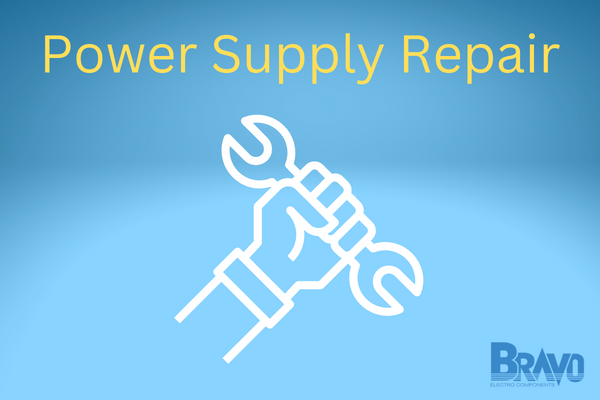
Curious about how to repair a power supply? You’ve come to the right place.
Power supplies are the lifeblood of your electronics, but when they falter, don't panic! Learn how to diagnose and fix common ACDC power supply issues, or explore the smarter choice of replacing it altogether with a reliable one from Bravo Electro. Discover all your options in this informative guide.
How Do You Diagnose a Dead Power Supply?
Diagnosing a dead power supply can be a tricky task, but understanding the signs of a malfunctioning power supply and how to properly diagnose the problem is crucial.
In this section, we'll explore various methods for diagnosing a dead power supply and discuss common symptoms to look out for
Visual Inspection
- The first step in diagnosing a dead power supply is to conduct a visual inspection of the unit. Look for any obvious signs of physical damage, such as bent or broken pins on the connectors, cracked or discolored components, or signs of overheating.
- Check for any loose or disconnected wires, and ensure that all of the connectors are securely seated in the power supply as well as the device it is connected to.
- Inspect the power supply's cooling fan, and ensure that it is not obstructed and is functioning properly. Make sure the fan is not making any strange noises or is not running too slow or too fast.
- Check the capacitors, if any of them are bulging or leaking, that is a sign that the power supply needs to be replaced.
Testing with a Multimeter
- A multimeter is an essential tool for diagnosing power supply issues, as it allows you to measure voltage, current, and continuity.
- To test the power supply voltage with a multimeter, you'll need to disconnect it from the device it's powering and set the multimeter to measure DC voltage.
- Test the voltage of each individual rail of the power supply, and compare the readings to the specifications listed in the power supply's manual or on the manufacturer's website. It is important to note that each rail of a power supply serves a different component of the device. For example, a 12V rail is used for the motherboard, and a 5V rail is used for the USB ports, etc.
- If the readings are significantly different from the specified values, this could indicate a problem with the power supply.
- It's also important to check the current draw of the power supply by connecting the multimeter in series with the load (the device that is powered by the power supply) and compare it with the maximum current capacity of the power supply.
Troubleshooting with Diagnostic Software
- Many power supply manufacturers offer diagnostic software that can help you troubleshoot issues with your unit. This is something most people learning how to repair a broken power supply simply overlook.
- This software can provide detailed information about the power supply's performance, including voltage and current readings, temperature, and fan speed.
- By analyzing this data, you may be able to identify the root cause of the problem and take the appropriate steps to fix it.
- You can also use software such as OCCT, AIDA64, and CPU-Z to monitor the power supply's performance, voltage, and temperature.
Common Symptoms to Look Out For
- Strange noises: A power supply that is making strange noises, such as whining, buzzing, or clicking, may be malfunctioning.
- Overheating: A power supply that is running hot to the touch or is emitting a burning smell could be on the verge of failure.
- No power output: If the device that the power supply is connected to is not turning on or is not functioning properly, it could be a sign that the power supply is dead.
- Random Shutdowns: If the device connected to the power supply is shutting down randomly, it could be a sign of a malfunctioning power supply.
- Low Voltage: If the device connected to the power supply is not functioning properly and the voltage readings are lower than the specified values, it could be a sign of a malfunctioning power supply.
Can You Repair a Power Supply?
So can you repair a power supply? Yes, it is possible to repair a power supply, depending on the specific issue you're experiencing. However, in many cases, it may be more cost-effective and safer to simply replace the unit with a new one, especially since most people don’t properly know how to repair power supplies.
When it comes to learning how to repair power supplies, it's important to first understand the difference between AC and DC power. A power supply converts AC power from your wall outlet into DC power, which is what your device needs to function. If you're experiencing issues with your power supply, it's important to understand whether the problem is with the AC side or the DC side.
Modular power supplies, which allow you to remove and replace individual components, can be easier to repair than non-modular power supplies. However, even with a modular power supply, you'll need to have a good understanding of electronics and experience with troubleshooting power supplies.
If you're experiencing issues with an LED driver, a component of the power supply that regulates the power going to the LEDs, you may be able to repair it by replacing the driver. We also have a detailed guide explaining how to tell if an LED driver is bad.
Two Options to Repair a Power Supply: DIY or Hiring a Trusted Repair Company
When it comes to fixing broken or damaged power supplies, there are two options: doing it yourself (DIY) or hiring a trusted repair company. While both options have their pros and cons, it's important to consider the potential risks and costs associated with each.
DIY repairs can be a cost-effective solution, but they also come with a higher level of risk. Attempting to repair a power supply requires a certain level of knowledge and experience with electronics and power supplies in order to be safe and avoid further damage.
On the other hand, hiring a trusted repair company can be a safer and more reliable option. A professional will have the knowledge and experience necessary to diagnose and repair the power supply, and they'll have the proper tools and equipment to do so. However, hiring a professional can be more expensive than DIY repairs.
It's important to note that both DIY and professional repairs are just a temporary solution. Repairing a broken power supply is just kicking the can further down the road. The best approach is to replace the unit altogether with a new, reliable, and efficient power supply from a reputable source like Bravo Electro.
But nonetheless, let’s talk about how to repair a broken power supply yourself.
How to Repair a Power Supply Yourself: Step-by-Step Guide
Even for those who know how to repair power supplies, the process can be a challenging task, and the steps required will vary depending on the specific issue and the components involved. However, there are a few easy and obvious things that can be done to fix some common issues.
Step 1: Identify The Problem
This can often be done with the visual inspection stage we mentioned earlier, which includes noticing obvious signs of physical damage, such as loose or disconnected wires, blown capacitors which can be recognized by their bulging or leaking tops, bent or broken pins on the connectors, cracked or discolored components, or signs of overheating.
Step 2: Gather the Necessary Tools and Materials
Before beginning any repairs, ensure that you have all the necessary tools and materials on hand. This may include a soldering iron, replacement components, thermal paste, etc.
Step 3: Make the Repair
- If you identified any blown capacitors, you can replace them with new ones. Make sure to match the capacitance and voltage rating of the new capacitor to the old one. Carefully remove the old capacitor and solder the new one in its place.
- If you identified any bent or broken pins on the connectors, carefully straighten or replace the connector.
- If you identified any loose or disconnected wires, re-solder the connections to ensure a secure connection.
- If the power supply is overheating, check for any dust or debris blocking the cooling fan and clean it. If the fan is not functioning, replace it with a new one of the same size and voltage rating.
Step 4: Test the Repaired Power Supply
Once the repairs are complete, test the power supply with a multimeter to ensure that it is functioning properly.
If Your Power Supply is Beyond Repair, Bravo Electro is Here to Help
When it comes to replacing a power supply, it's important to choose a reliable and efficient unit from a reputable source. But first, make sure you understand UL-listed vs UL-recognized. A UL-listed power supply has been evaluated by Underwriters Laboratories and has met their safety standards, while a UL-recognized power supply has not been evaluated but has been determined to be similar to a UL-listed power supply.
So who makes the best power supplies? Here at Bravo Electro we have partnered with the highest-rated manufacturers in the country and have stellar customer service and quick shipping.
We offer a wide range of power supplies to meet the needs of any device including a 12v DC power supply, 24v DC power supply, and a 48v DC power supply among other products.
One of the key benefits of choosing Bravo Electro for your power supply needs is our excellent customer service. Our team is knowledgeable and experienced in troubleshooting power supplies and they'll work with you to find the right solution for your specific device and application.
Whether you're not sure if your house electric is AC or DC, or you're experiencing issues with your power supply, we’re here to help.
Final Thoughts on How to Repair Power Supplies
When it comes to power supplies, one thing is for certain: issues can arise at any time, leaving you in a state of confusion and frustration. But, fear not! The process of troubleshooting and repairing a power supply doesn't have to be a daunting task.
More often than not, it’s simply more cost-effective and safer to just replace the unit with a new one from a reputable source like Bravo Electro. We offer a wide range of power supplies, including enclosed power supplies, open-frame power supplies, DIN rail power supplies, and AC DC LED drivers. We also provide excellent customer service and custom solutions for specific applications.
If you're experiencing issues with your power supply, don't hesitate to reach out to Bravo Electro for help!















